Britvic: Comprehensive Analysis of Business Environment and Strategy
VerifiedAdded on 2020/10/22
|11
|3792
|97
Report
AI Summary
This report provides a comprehensive analysis of Britvic, a British soft drink producer, focusing on its business environment. It begins by identifying macro-environmental factors, including political, economic, social, technological, ecological, and legal influences. The report then delves into micro-environmental factors, analyzing the impact of employees, distribution channels, suppliers, competition, investors, media, and the public. Porter's Five Forces model is applied to assess the competitive landscape, including industry competition, potential new entrants, supplier power, customer power, and the threat of substitutes. Furthermore, the internal business environment is examined using value chain analysis, detailing primary activities such as inbound logistics, production, outbound logistics, marketing and sales, and service, as well as support activities like firm infrastructure, human resource management, technology development, and procurement. The report concludes with a discussion of appropriate adaptations for Britvic based on the environmental and internal analyses.

Reflective
Account
Account
Paraphrase This Document
Need a fresh take? Get an instant paraphrase of this document with our AI Paraphraser
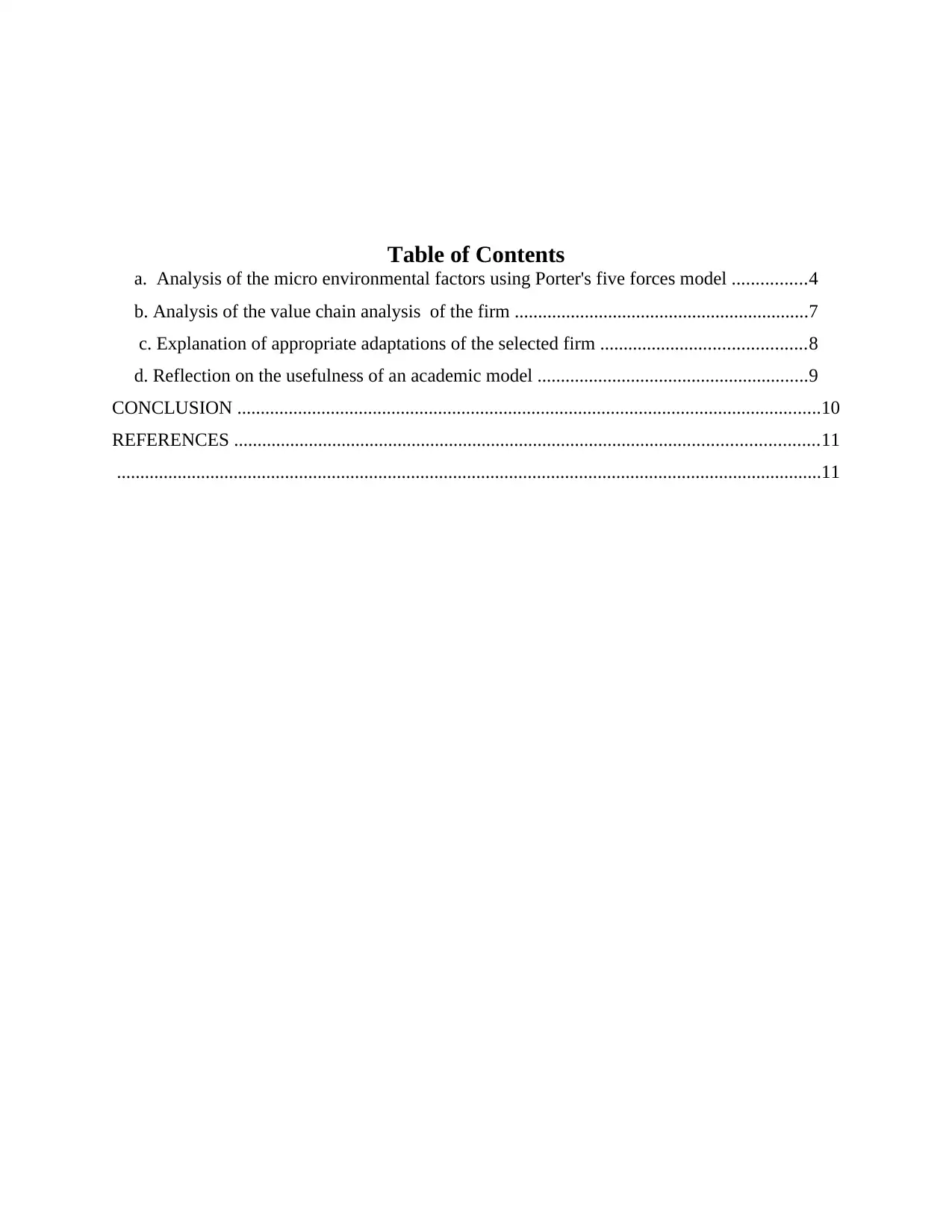
Table of Contents
a. Analysis of the micro environmental factors using Porter's five forces model ................4
b. Analysis of the value chain analysis of the firm ...............................................................7
c. Explanation of appropriate adaptations of the selected firm ............................................8
d. Reflection on the usefulness of an academic model ..........................................................9
CONCLUSION .............................................................................................................................10
REFERENCES .............................................................................................................................11
.......................................................................................................................................................11
a. Analysis of the micro environmental factors using Porter's five forces model ................4
b. Analysis of the value chain analysis of the firm ...............................................................7
c. Explanation of appropriate adaptations of the selected firm ............................................8
d. Reflection on the usefulness of an academic model ..........................................................9
CONCLUSION .............................................................................................................................10
REFERENCES .............................................................................................................................11
.......................................................................................................................................................11
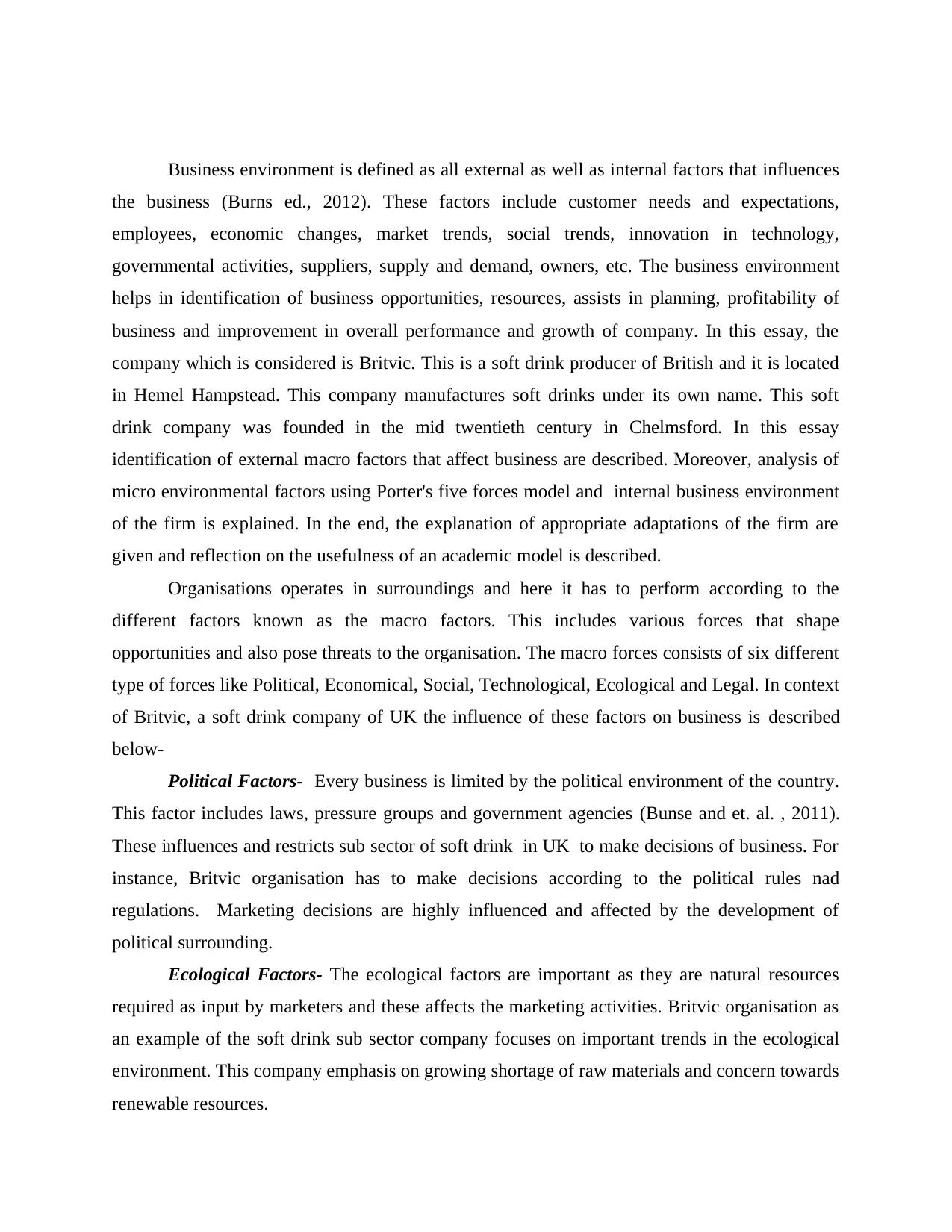
Business environment is defined as all external as well as internal factors that influences
the business (Burns ed., 2012). These factors include customer needs and expectations,
employees, economic changes, market trends, social trends, innovation in technology,
governmental activities, suppliers, supply and demand, owners, etc. The business environment
helps in identification of business opportunities, resources, assists in planning, profitability of
business and improvement in overall performance and growth of company. In this essay, the
company which is considered is Britvic. This is a soft drink producer of British and it is located
in Hemel Hampstead. This company manufactures soft drinks under its own name. This soft
drink company was founded in the mid twentieth century in Chelmsford. In this essay
identification of external macro factors that affect business are described. Moreover, analysis of
micro environmental factors using Porter's five forces model and internal business environment
of the firm is explained. In the end, the explanation of appropriate adaptations of the firm are
given and reflection on the usefulness of an academic model is described.
Organisations operates in surroundings and here it has to perform according to the
different factors known as the macro factors. This includes various forces that shape
opportunities and also pose threats to the organisation. The macro forces consists of six different
type of forces like Political, Economical, Social, Technological, Ecological and Legal. In context
of Britvic, a soft drink company of UK the influence of these factors on business is described
below-
Political Factors- Every business is limited by the political environment of the country.
This factor includes laws, pressure groups and government agencies (Bunse and et. al. , 2011).
These influences and restricts sub sector of soft drink in UK to make decisions of business. For
instance, Britvic organisation has to make decisions according to the political rules nad
regulations. Marketing decisions are highly influenced and affected by the development of
political surrounding.
Ecological Factors- The ecological factors are important as they are natural resources
required as input by marketers and these affects the marketing activities. Britvic organisation as
an example of the soft drink sub sector company focuses on important trends in the ecological
environment. This company emphasis on growing shortage of raw materials and concern towards
renewable resources.
the business (Burns ed., 2012). These factors include customer needs and expectations,
employees, economic changes, market trends, social trends, innovation in technology,
governmental activities, suppliers, supply and demand, owners, etc. The business environment
helps in identification of business opportunities, resources, assists in planning, profitability of
business and improvement in overall performance and growth of company. In this essay, the
company which is considered is Britvic. This is a soft drink producer of British and it is located
in Hemel Hampstead. This company manufactures soft drinks under its own name. This soft
drink company was founded in the mid twentieth century in Chelmsford. In this essay
identification of external macro factors that affect business are described. Moreover, analysis of
micro environmental factors using Porter's five forces model and internal business environment
of the firm is explained. In the end, the explanation of appropriate adaptations of the firm are
given and reflection on the usefulness of an academic model is described.
Organisations operates in surroundings and here it has to perform according to the
different factors known as the macro factors. This includes various forces that shape
opportunities and also pose threats to the organisation. The macro forces consists of six different
type of forces like Political, Economical, Social, Technological, Ecological and Legal. In context
of Britvic, a soft drink company of UK the influence of these factors on business is described
below-
Political Factors- Every business is limited by the political environment of the country.
This factor includes laws, pressure groups and government agencies (Bunse and et. al. , 2011).
These influences and restricts sub sector of soft drink in UK to make decisions of business. For
instance, Britvic organisation has to make decisions according to the political rules nad
regulations. Marketing decisions are highly influenced and affected by the development of
political surrounding.
Ecological Factors- The ecological factors are important as they are natural resources
required as input by marketers and these affects the marketing activities. Britvic organisation as
an example of the soft drink sub sector company focuses on important trends in the ecological
environment. This company emphasis on growing shortage of raw materials and concern towards
renewable resources.
⊘ This is a preview!⊘
Do you want full access?
Subscribe today to unlock all pages.

Trusted by 1+ million students worldwide
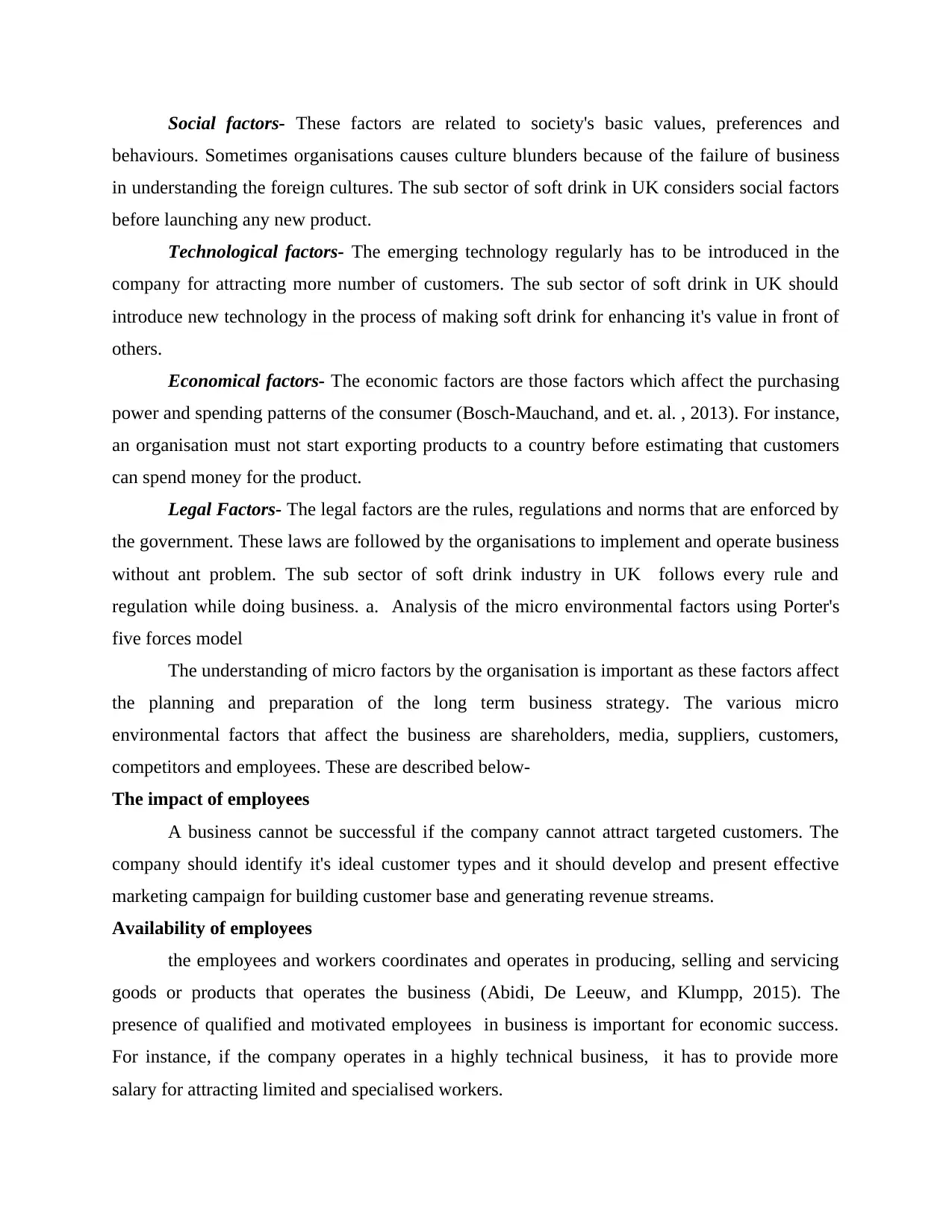
Social factors- These factors are related to society's basic values, preferences and
behaviours. Sometimes organisations causes culture blunders because of the failure of business
in understanding the foreign cultures. The sub sector of soft drink in UK considers social factors
before launching any new product.
Technological factors- The emerging technology regularly has to be introduced in the
company for attracting more number of customers. The sub sector of soft drink in UK should
introduce new technology in the process of making soft drink for enhancing it's value in front of
others.
Economical factors- The economic factors are those factors which affect the purchasing
power and spending patterns of the consumer (Bosch-Mauchand, and et. al. , 2013). For instance,
an organisation must not start exporting products to a country before estimating that customers
can spend money for the product.
Legal Factors- The legal factors are the rules, regulations and norms that are enforced by
the government. These laws are followed by the organisations to implement and operate business
without ant problem. The sub sector of soft drink industry in UK follows every rule and
regulation while doing business. a. Analysis of the micro environmental factors using Porter's
five forces model
The understanding of micro factors by the organisation is important as these factors affect
the planning and preparation of the long term business strategy. The various micro
environmental factors that affect the business are shareholders, media, suppliers, customers,
competitors and employees. These are described below-
The impact of employees
A business cannot be successful if the company cannot attract targeted customers. The
company should identify it's ideal customer types and it should develop and present effective
marketing campaign for building customer base and generating revenue streams.
Availability of employees
the employees and workers coordinates and operates in producing, selling and servicing
goods or products that operates the business (Abidi, De Leeuw, and Klumpp, 2015). The
presence of qualified and motivated employees in business is important for economic success.
For instance, if the company operates in a highly technical business, it has to provide more
salary for attracting limited and specialised workers.
behaviours. Sometimes organisations causes culture blunders because of the failure of business
in understanding the foreign cultures. The sub sector of soft drink in UK considers social factors
before launching any new product.
Technological factors- The emerging technology regularly has to be introduced in the
company for attracting more number of customers. The sub sector of soft drink in UK should
introduce new technology in the process of making soft drink for enhancing it's value in front of
others.
Economical factors- The economic factors are those factors which affect the purchasing
power and spending patterns of the consumer (Bosch-Mauchand, and et. al. , 2013). For instance,
an organisation must not start exporting products to a country before estimating that customers
can spend money for the product.
Legal Factors- The legal factors are the rules, regulations and norms that are enforced by
the government. These laws are followed by the organisations to implement and operate business
without ant problem. The sub sector of soft drink industry in UK follows every rule and
regulation while doing business. a. Analysis of the micro environmental factors using Porter's
five forces model
The understanding of micro factors by the organisation is important as these factors affect
the planning and preparation of the long term business strategy. The various micro
environmental factors that affect the business are shareholders, media, suppliers, customers,
competitors and employees. These are described below-
The impact of employees
A business cannot be successful if the company cannot attract targeted customers. The
company should identify it's ideal customer types and it should develop and present effective
marketing campaign for building customer base and generating revenue streams.
Availability of employees
the employees and workers coordinates and operates in producing, selling and servicing
goods or products that operates the business (Abidi, De Leeuw, and Klumpp, 2015). The
presence of qualified and motivated employees in business is important for economic success.
For instance, if the company operates in a highly technical business, it has to provide more
salary for attracting limited and specialised workers.
Paraphrase This Document
Need a fresh take? Get an instant paraphrase of this document with our AI Paraphraser
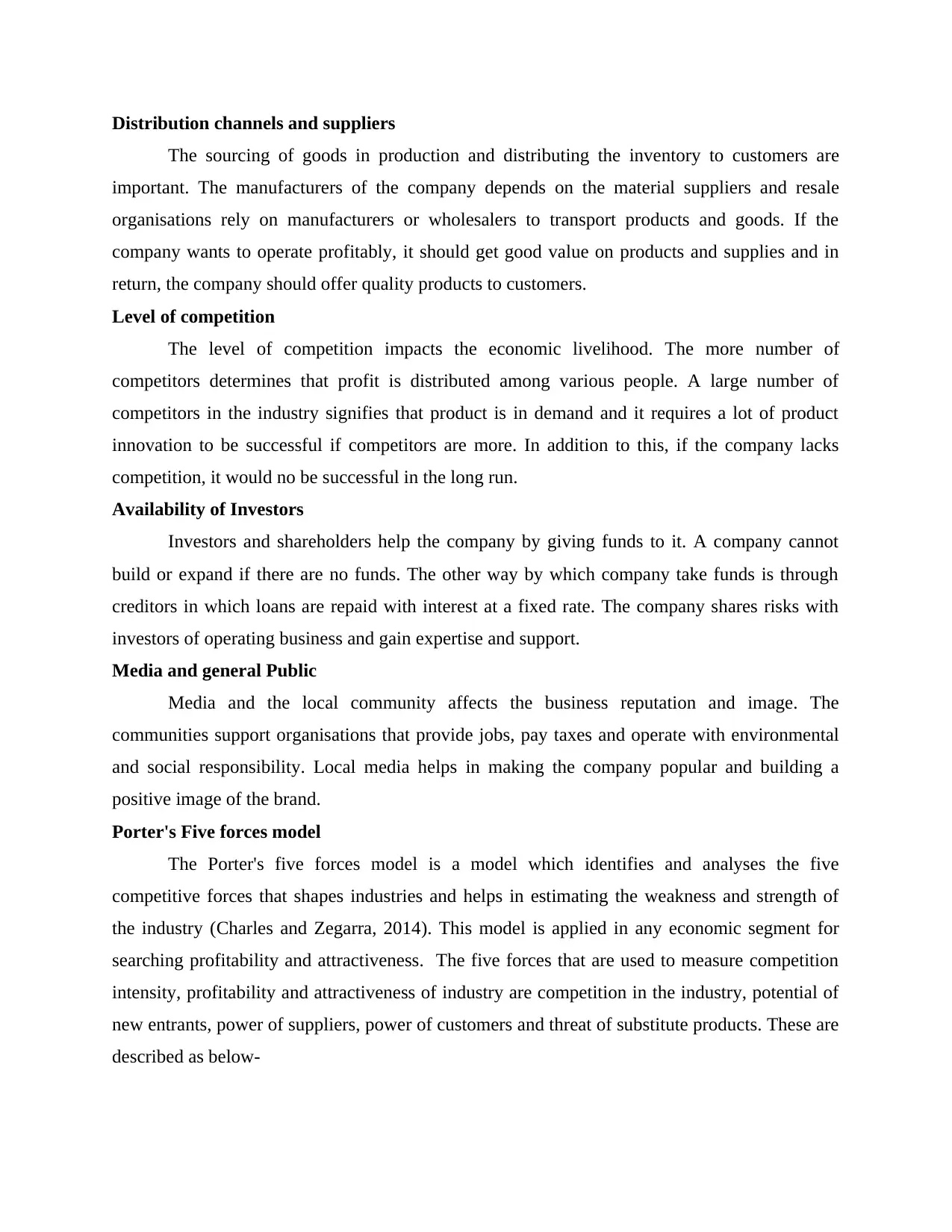
Distribution channels and suppliers
The sourcing of goods in production and distributing the inventory to customers are
important. The manufacturers of the company depends on the material suppliers and resale
organisations rely on manufacturers or wholesalers to transport products and goods. If the
company wants to operate profitably, it should get good value on products and supplies and in
return, the company should offer quality products to customers.
Level of competition
The level of competition impacts the economic livelihood. The more number of
competitors determines that profit is distributed among various people. A large number of
competitors in the industry signifies that product is in demand and it requires a lot of product
innovation to be successful if competitors are more. In addition to this, if the company lacks
competition, it would no be successful in the long run.
Availability of Investors
Investors and shareholders help the company by giving funds to it. A company cannot
build or expand if there are no funds. The other way by which company take funds is through
creditors in which loans are repaid with interest at a fixed rate. The company shares risks with
investors of operating business and gain expertise and support.
Media and general Public
Media and the local community affects the business reputation and image. The
communities support organisations that provide jobs, pay taxes and operate with environmental
and social responsibility. Local media helps in making the company popular and building a
positive image of the brand.
Porter's Five forces model
The Porter's five forces model is a model which identifies and analyses the five
competitive forces that shapes industries and helps in estimating the weakness and strength of
the industry (Charles and Zegarra, 2014). This model is applied in any economic segment for
searching profitability and attractiveness. The five forces that are used to measure competition
intensity, profitability and attractiveness of industry are competition in the industry, potential of
new entrants, power of suppliers, power of customers and threat of substitute products. These are
described as below-
The sourcing of goods in production and distributing the inventory to customers are
important. The manufacturers of the company depends on the material suppliers and resale
organisations rely on manufacturers or wholesalers to transport products and goods. If the
company wants to operate profitably, it should get good value on products and supplies and in
return, the company should offer quality products to customers.
Level of competition
The level of competition impacts the economic livelihood. The more number of
competitors determines that profit is distributed among various people. A large number of
competitors in the industry signifies that product is in demand and it requires a lot of product
innovation to be successful if competitors are more. In addition to this, if the company lacks
competition, it would no be successful in the long run.
Availability of Investors
Investors and shareholders help the company by giving funds to it. A company cannot
build or expand if there are no funds. The other way by which company take funds is through
creditors in which loans are repaid with interest at a fixed rate. The company shares risks with
investors of operating business and gain expertise and support.
Media and general Public
Media and the local community affects the business reputation and image. The
communities support organisations that provide jobs, pay taxes and operate with environmental
and social responsibility. Local media helps in making the company popular and building a
positive image of the brand.
Porter's Five forces model
The Porter's five forces model is a model which identifies and analyses the five
competitive forces that shapes industries and helps in estimating the weakness and strength of
the industry (Charles and Zegarra, 2014). This model is applied in any economic segment for
searching profitability and attractiveness. The five forces that are used to measure competition
intensity, profitability and attractiveness of industry are competition in the industry, potential of
new entrants, power of suppliers, power of customers and threat of substitute products. These are
described as below-
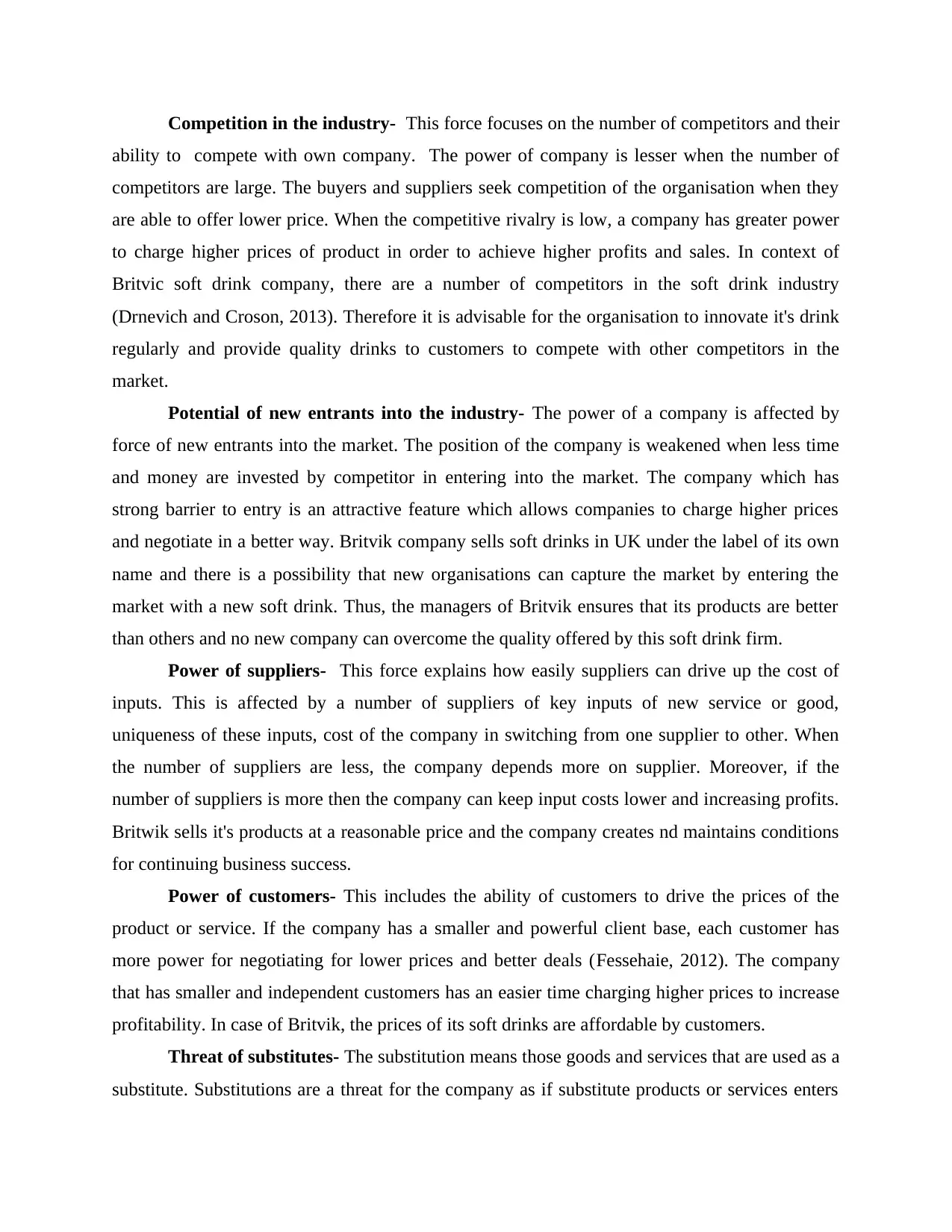
Competition in the industry- This force focuses on the number of competitors and their
ability to compete with own company. The power of company is lesser when the number of
competitors are large. The buyers and suppliers seek competition of the organisation when they
are able to offer lower price. When the competitive rivalry is low, a company has greater power
to charge higher prices of product in order to achieve higher profits and sales. In context of
Britvic soft drink company, there are a number of competitors in the soft drink industry
(Drnevich and Croson, 2013). Therefore it is advisable for the organisation to innovate it's drink
regularly and provide quality drinks to customers to compete with other competitors in the
market.
Potential of new entrants into the industry- The power of a company is affected by
force of new entrants into the market. The position of the company is weakened when less time
and money are invested by competitor in entering into the market. The company which has
strong barrier to entry is an attractive feature which allows companies to charge higher prices
and negotiate in a better way. Britvik company sells soft drinks in UK under the label of its own
name and there is a possibility that new organisations can capture the market by entering the
market with a new soft drink. Thus, the managers of Britvik ensures that its products are better
than others and no new company can overcome the quality offered by this soft drink firm.
Power of suppliers- This force explains how easily suppliers can drive up the cost of
inputs. This is affected by a number of suppliers of key inputs of new service or good,
uniqueness of these inputs, cost of the company in switching from one supplier to other. When
the number of suppliers are less, the company depends more on supplier. Moreover, if the
number of suppliers is more then the company can keep input costs lower and increasing profits.
Britwik sells it's products at a reasonable price and the company creates nd maintains conditions
for continuing business success.
Power of customers- This includes the ability of customers to drive the prices of the
product or service. If the company has a smaller and powerful client base, each customer has
more power for negotiating for lower prices and better deals (Fessehaie, 2012). The company
that has smaller and independent customers has an easier time charging higher prices to increase
profitability. In case of Britvik, the prices of its soft drinks are affordable by customers.
Threat of substitutes- The substitution means those goods and services that are used as a
substitute. Substitutions are a threat for the company as if substitute products or services enters
ability to compete with own company. The power of company is lesser when the number of
competitors are large. The buyers and suppliers seek competition of the organisation when they
are able to offer lower price. When the competitive rivalry is low, a company has greater power
to charge higher prices of product in order to achieve higher profits and sales. In context of
Britvic soft drink company, there are a number of competitors in the soft drink industry
(Drnevich and Croson, 2013). Therefore it is advisable for the organisation to innovate it's drink
regularly and provide quality drinks to customers to compete with other competitors in the
market.
Potential of new entrants into the industry- The power of a company is affected by
force of new entrants into the market. The position of the company is weakened when less time
and money are invested by competitor in entering into the market. The company which has
strong barrier to entry is an attractive feature which allows companies to charge higher prices
and negotiate in a better way. Britvik company sells soft drinks in UK under the label of its own
name and there is a possibility that new organisations can capture the market by entering the
market with a new soft drink. Thus, the managers of Britvik ensures that its products are better
than others and no new company can overcome the quality offered by this soft drink firm.
Power of suppliers- This force explains how easily suppliers can drive up the cost of
inputs. This is affected by a number of suppliers of key inputs of new service or good,
uniqueness of these inputs, cost of the company in switching from one supplier to other. When
the number of suppliers are less, the company depends more on supplier. Moreover, if the
number of suppliers is more then the company can keep input costs lower and increasing profits.
Britwik sells it's products at a reasonable price and the company creates nd maintains conditions
for continuing business success.
Power of customers- This includes the ability of customers to drive the prices of the
product or service. If the company has a smaller and powerful client base, each customer has
more power for negotiating for lower prices and better deals (Fessehaie, 2012). The company
that has smaller and independent customers has an easier time charging higher prices to increase
profitability. In case of Britvik, the prices of its soft drinks are affordable by customers.
Threat of substitutes- The substitution means those goods and services that are used as a
substitute. Substitutions are a threat for the company as if substitute products or services enters
⊘ This is a preview!⊘
Do you want full access?
Subscribe today to unlock all pages.

Trusted by 1+ million students worldwide
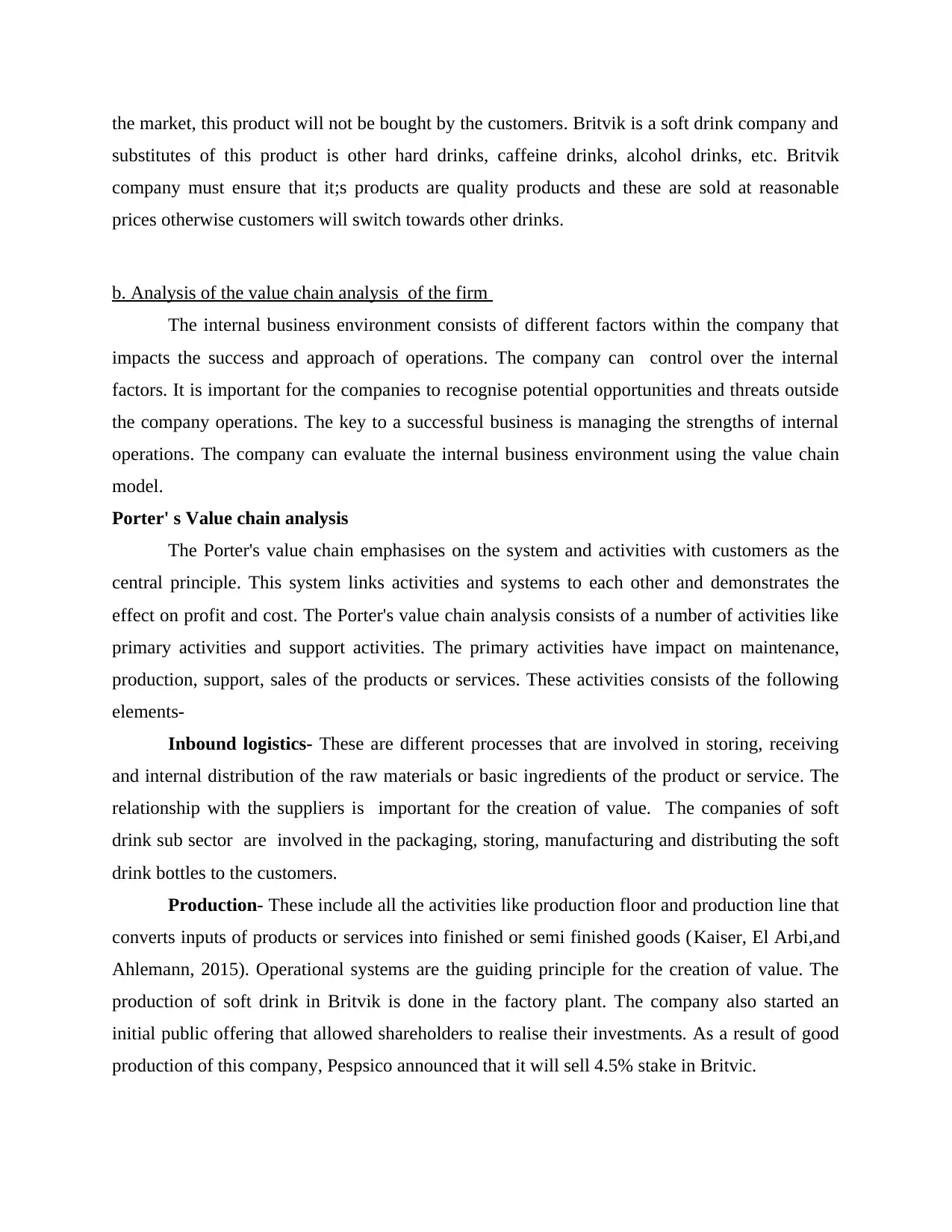
the market, this product will not be bought by the customers. Britvik is a soft drink company and
substitutes of this product is other hard drinks, caffeine drinks, alcohol drinks, etc. Britvik
company must ensure that it;s products are quality products and these are sold at reasonable
prices otherwise customers will switch towards other drinks.
b. Analysis of the value chain analysis of the firm
The internal business environment consists of different factors within the company that
impacts the success and approach of operations. The company can control over the internal
factors. It is important for the companies to recognise potential opportunities and threats outside
the company operations. The key to a successful business is managing the strengths of internal
operations. The company can evaluate the internal business environment using the value chain
model.
Porter' s Value chain analysis
The Porter's value chain emphasises on the system and activities with customers as the
central principle. This system links activities and systems to each other and demonstrates the
effect on profit and cost. The Porter's value chain analysis consists of a number of activities like
primary activities and support activities. The primary activities have impact on maintenance,
production, support, sales of the products or services. These activities consists of the following
elements-
Inbound logistics- These are different processes that are involved in storing, receiving
and internal distribution of the raw materials or basic ingredients of the product or service. The
relationship with the suppliers is important for the creation of value. The companies of soft
drink sub sector are involved in the packaging, storing, manufacturing and distributing the soft
drink bottles to the customers.
Production- These include all the activities like production floor and production line that
converts inputs of products or services into finished or semi finished goods (Kaiser, El Arbi,and
Ahlemann, 2015). Operational systems are the guiding principle for the creation of value. The
production of soft drink in Britvik is done in the factory plant. The company also started an
initial public offering that allowed shareholders to realise their investments. As a result of good
production of this company, Pespsico announced that it will sell 4.5% stake in Britvic.
substitutes of this product is other hard drinks, caffeine drinks, alcohol drinks, etc. Britvik
company must ensure that it;s products are quality products and these are sold at reasonable
prices otherwise customers will switch towards other drinks.
b. Analysis of the value chain analysis of the firm
The internal business environment consists of different factors within the company that
impacts the success and approach of operations. The company can control over the internal
factors. It is important for the companies to recognise potential opportunities and threats outside
the company operations. The key to a successful business is managing the strengths of internal
operations. The company can evaluate the internal business environment using the value chain
model.
Porter' s Value chain analysis
The Porter's value chain emphasises on the system and activities with customers as the
central principle. This system links activities and systems to each other and demonstrates the
effect on profit and cost. The Porter's value chain analysis consists of a number of activities like
primary activities and support activities. The primary activities have impact on maintenance,
production, support, sales of the products or services. These activities consists of the following
elements-
Inbound logistics- These are different processes that are involved in storing, receiving
and internal distribution of the raw materials or basic ingredients of the product or service. The
relationship with the suppliers is important for the creation of value. The companies of soft
drink sub sector are involved in the packaging, storing, manufacturing and distributing the soft
drink bottles to the customers.
Production- These include all the activities like production floor and production line that
converts inputs of products or services into finished or semi finished goods (Kaiser, El Arbi,and
Ahlemann, 2015). Operational systems are the guiding principle for the creation of value. The
production of soft drink in Britvik is done in the factory plant. The company also started an
initial public offering that allowed shareholders to realise their investments. As a result of good
production of this company, Pespsico announced that it will sell 4.5% stake in Britvic.
Paraphrase This Document
Need a fresh take? Get an instant paraphrase of this document with our AI Paraphraser
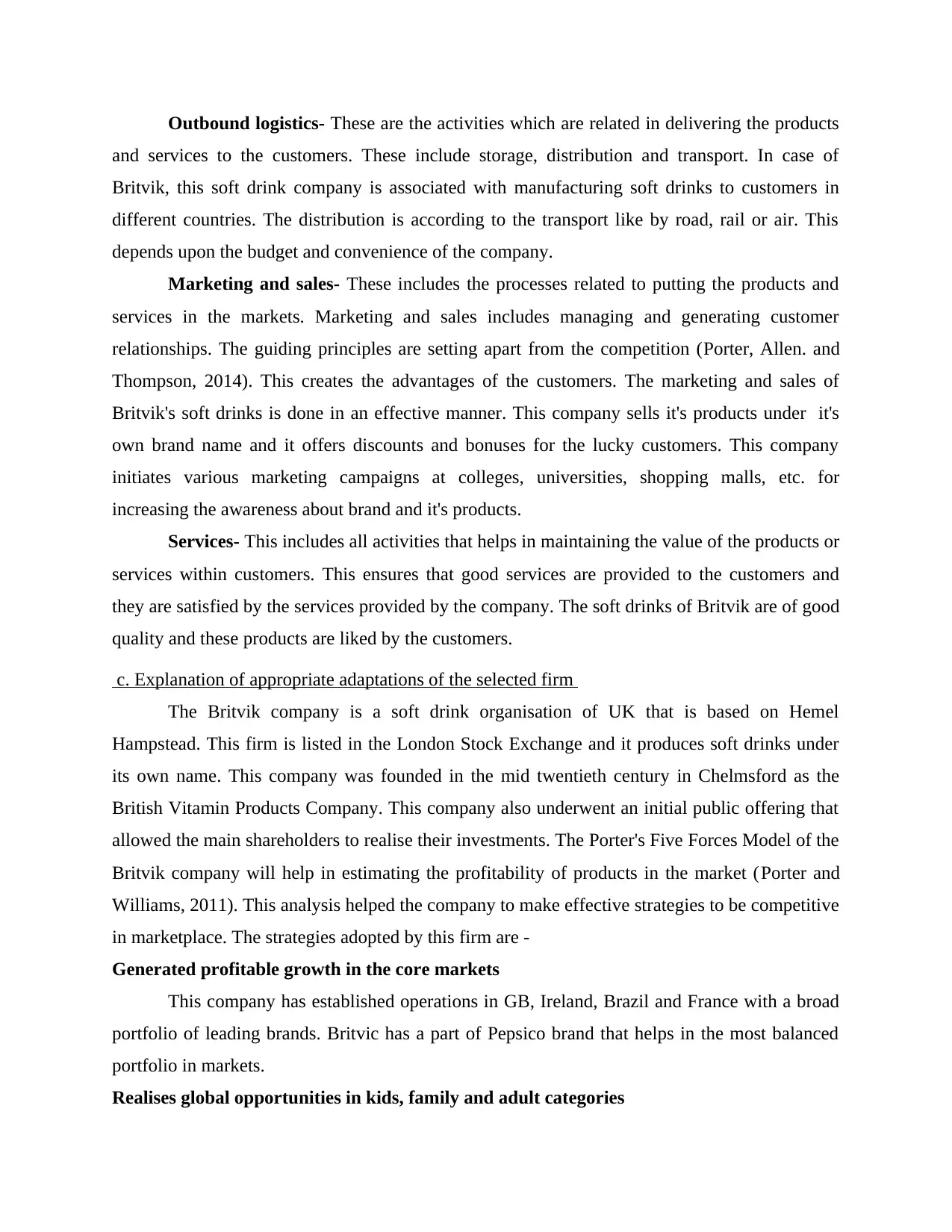
Outbound logistics- These are the activities which are related in delivering the products
and services to the customers. These include storage, distribution and transport. In case of
Britvik, this soft drink company is associated with manufacturing soft drinks to customers in
different countries. The distribution is according to the transport like by road, rail or air. This
depends upon the budget and convenience of the company.
Marketing and sales- These includes the processes related to putting the products and
services in the markets. Marketing and sales includes managing and generating customer
relationships. The guiding principles are setting apart from the competition (Porter, Allen. and
Thompson, 2014). This creates the advantages of the customers. The marketing and sales of
Britvik's soft drinks is done in an effective manner. This company sells it's products under it's
own brand name and it offers discounts and bonuses for the lucky customers. This company
initiates various marketing campaigns at colleges, universities, shopping malls, etc. for
increasing the awareness about brand and it's products.
Services- This includes all activities that helps in maintaining the value of the products or
services within customers. This ensures that good services are provided to the customers and
they are satisfied by the services provided by the company. The soft drinks of Britvik are of good
quality and these products are liked by the customers.
c. Explanation of appropriate adaptations of the selected firm
The Britvik company is a soft drink organisation of UK that is based on Hemel
Hampstead. This firm is listed in the London Stock Exchange and it produces soft drinks under
its own name. This company was founded in the mid twentieth century in Chelmsford as the
British Vitamin Products Company. This company also underwent an initial public offering that
allowed the main shareholders to realise their investments. The Porter's Five Forces Model of the
Britvik company will help in estimating the profitability of products in the market (Porter and
Williams, 2011). This analysis helped the company to make effective strategies to be competitive
in marketplace. The strategies adopted by this firm are -
Generated profitable growth in the core markets
This company has established operations in GB, Ireland, Brazil and France with a broad
portfolio of leading brands. Britvic has a part of Pepsico brand that helps in the most balanced
portfolio in markets.
Realises global opportunities in kids, family and adult categories
and services to the customers. These include storage, distribution and transport. In case of
Britvik, this soft drink company is associated with manufacturing soft drinks to customers in
different countries. The distribution is according to the transport like by road, rail or air. This
depends upon the budget and convenience of the company.
Marketing and sales- These includes the processes related to putting the products and
services in the markets. Marketing and sales includes managing and generating customer
relationships. The guiding principles are setting apart from the competition (Porter, Allen. and
Thompson, 2014). This creates the advantages of the customers. The marketing and sales of
Britvik's soft drinks is done in an effective manner. This company sells it's products under it's
own brand name and it offers discounts and bonuses for the lucky customers. This company
initiates various marketing campaigns at colleges, universities, shopping malls, etc. for
increasing the awareness about brand and it's products.
Services- This includes all activities that helps in maintaining the value of the products or
services within customers. This ensures that good services are provided to the customers and
they are satisfied by the services provided by the company. The soft drinks of Britvik are of good
quality and these products are liked by the customers.
c. Explanation of appropriate adaptations of the selected firm
The Britvik company is a soft drink organisation of UK that is based on Hemel
Hampstead. This firm is listed in the London Stock Exchange and it produces soft drinks under
its own name. This company was founded in the mid twentieth century in Chelmsford as the
British Vitamin Products Company. This company also underwent an initial public offering that
allowed the main shareholders to realise their investments. The Porter's Five Forces Model of the
Britvik company will help in estimating the profitability of products in the market (Porter and
Williams, 2011). This analysis helped the company to make effective strategies to be competitive
in marketplace. The strategies adopted by this firm are -
Generated profitable growth in the core markets
This company has established operations in GB, Ireland, Brazil and France with a broad
portfolio of leading brands. Britvic has a part of Pepsico brand that helps in the most balanced
portfolio in markets.
Realises global opportunities in kids, family and adult categories
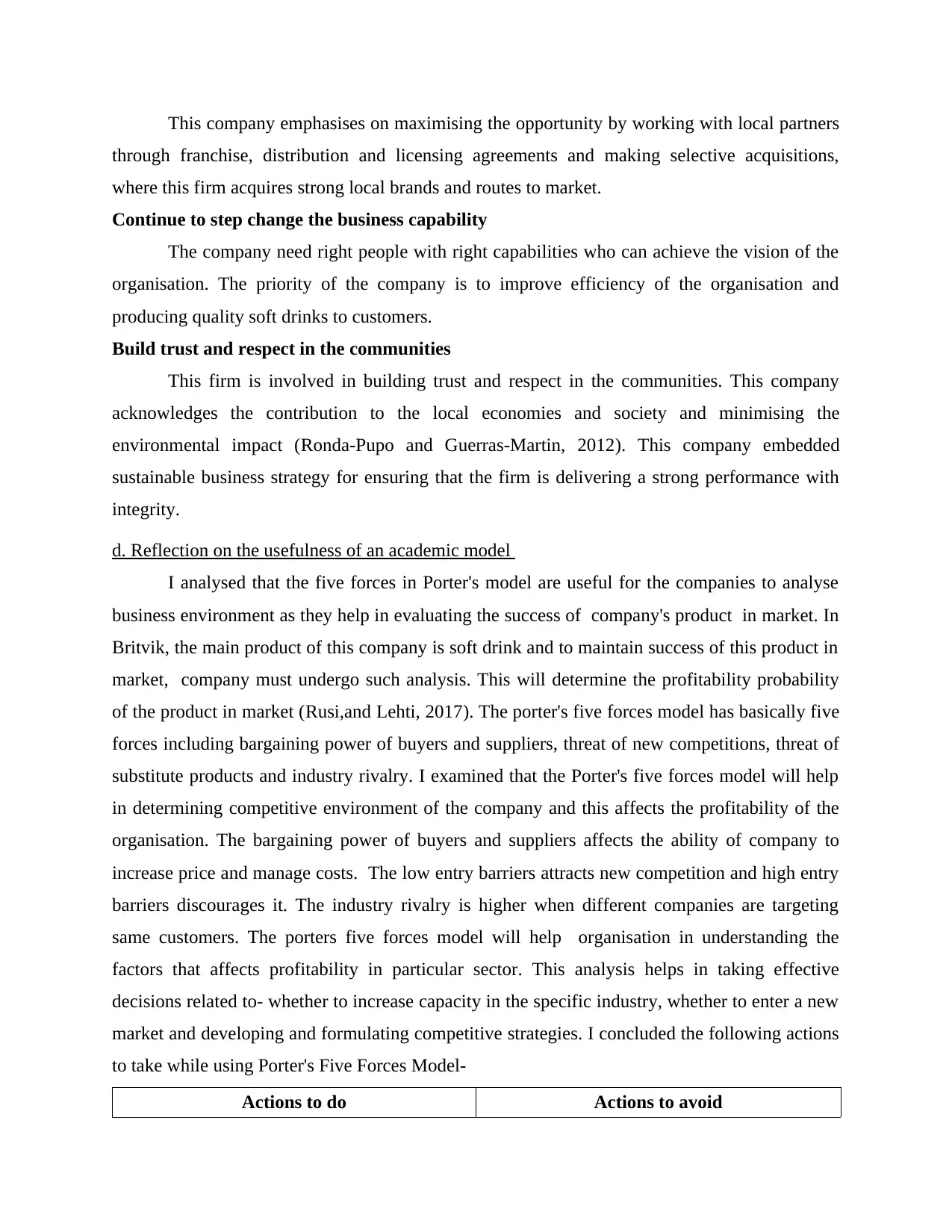
This company emphasises on maximising the opportunity by working with local partners
through franchise, distribution and licensing agreements and making selective acquisitions,
where this firm acquires strong local brands and routes to market.
Continue to step change the business capability
The company need right people with right capabilities who can achieve the vision of the
organisation. The priority of the company is to improve efficiency of the organisation and
producing quality soft drinks to customers.
Build trust and respect in the communities
This firm is involved in building trust and respect in the communities. This company
acknowledges the contribution to the local economies and society and minimising the
environmental impact (Ronda‐Pupo and Guerras‐Martin, 2012). This company embedded
sustainable business strategy for ensuring that the firm is delivering a strong performance with
integrity.
d. Reflection on the usefulness of an academic model
I analysed that the five forces in Porter's model are useful for the companies to analyse
business environment as they help in evaluating the success of company's product in market. In
Britvik, the main product of this company is soft drink and to maintain success of this product in
market, company must undergo such analysis. This will determine the profitability probability
of the product in market (Rusi,and Lehti, 2017). The porter's five forces model has basically five
forces including bargaining power of buyers and suppliers, threat of new competitions, threat of
substitute products and industry rivalry. I examined that the Porter's five forces model will help
in determining competitive environment of the company and this affects the profitability of the
organisation. The bargaining power of buyers and suppliers affects the ability of company to
increase price and manage costs. The low entry barriers attracts new competition and high entry
barriers discourages it. The industry rivalry is higher when different companies are targeting
same customers. The porters five forces model will help organisation in understanding the
factors that affects profitability in particular sector. This analysis helps in taking effective
decisions related to- whether to increase capacity in the specific industry, whether to enter a new
market and developing and formulating competitive strategies. I concluded the following actions
to take while using Porter's Five Forces Model-
Actions to do Actions to avoid
through franchise, distribution and licensing agreements and making selective acquisitions,
where this firm acquires strong local brands and routes to market.
Continue to step change the business capability
The company need right people with right capabilities who can achieve the vision of the
organisation. The priority of the company is to improve efficiency of the organisation and
producing quality soft drinks to customers.
Build trust and respect in the communities
This firm is involved in building trust and respect in the communities. This company
acknowledges the contribution to the local economies and society and minimising the
environmental impact (Ronda‐Pupo and Guerras‐Martin, 2012). This company embedded
sustainable business strategy for ensuring that the firm is delivering a strong performance with
integrity.
d. Reflection on the usefulness of an academic model
I analysed that the five forces in Porter's model are useful for the companies to analyse
business environment as they help in evaluating the success of company's product in market. In
Britvik, the main product of this company is soft drink and to maintain success of this product in
market, company must undergo such analysis. This will determine the profitability probability
of the product in market (Rusi,and Lehti, 2017). The porter's five forces model has basically five
forces including bargaining power of buyers and suppliers, threat of new competitions, threat of
substitute products and industry rivalry. I examined that the Porter's five forces model will help
in determining competitive environment of the company and this affects the profitability of the
organisation. The bargaining power of buyers and suppliers affects the ability of company to
increase price and manage costs. The low entry barriers attracts new competition and high entry
barriers discourages it. The industry rivalry is higher when different companies are targeting
same customers. The porters five forces model will help organisation in understanding the
factors that affects profitability in particular sector. This analysis helps in taking effective
decisions related to- whether to increase capacity in the specific industry, whether to enter a new
market and developing and formulating competitive strategies. I concluded the following actions
to take while using Porter's Five Forces Model-
Actions to do Actions to avoid
⊘ This is a preview!⊘
Do you want full access?
Subscribe today to unlock all pages.

Trusted by 1+ million students worldwide
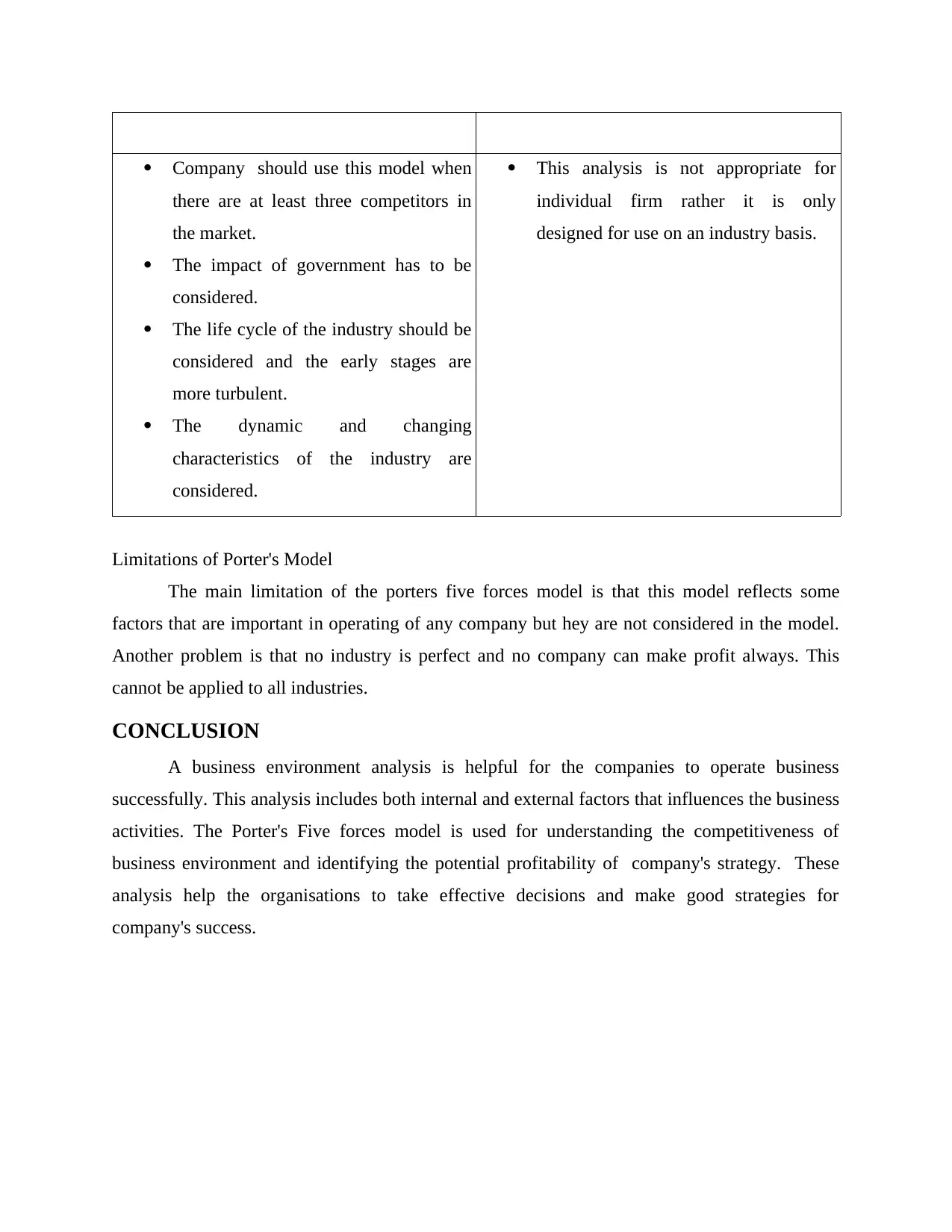
Company should use this model when
there are at least three competitors in
the market.
The impact of government has to be
considered.
The life cycle of the industry should be
considered and the early stages are
more turbulent.
The dynamic and changing
characteristics of the industry are
considered.
This analysis is not appropriate for
individual firm rather it is only
designed for use on an industry basis.
Limitations of Porter's Model
The main limitation of the porters five forces model is that this model reflects some
factors that are important in operating of any company but hey are not considered in the model.
Another problem is that no industry is perfect and no company can make profit always. This
cannot be applied to all industries.
CONCLUSION
A business environment analysis is helpful for the companies to operate business
successfully. This analysis includes both internal and external factors that influences the business
activities. The Porter's Five forces model is used for understanding the competitiveness of
business environment and identifying the potential profitability of company's strategy. These
analysis help the organisations to take effective decisions and make good strategies for
company's success.
there are at least three competitors in
the market.
The impact of government has to be
considered.
The life cycle of the industry should be
considered and the early stages are
more turbulent.
The dynamic and changing
characteristics of the industry are
considered.
This analysis is not appropriate for
individual firm rather it is only
designed for use on an industry basis.
Limitations of Porter's Model
The main limitation of the porters five forces model is that this model reflects some
factors that are important in operating of any company but hey are not considered in the model.
Another problem is that no industry is perfect and no company can make profit always. This
cannot be applied to all industries.
CONCLUSION
A business environment analysis is helpful for the companies to operate business
successfully. This analysis includes both internal and external factors that influences the business
activities. The Porter's Five forces model is used for understanding the competitiveness of
business environment and identifying the potential profitability of company's strategy. These
analysis help the organisations to take effective decisions and make good strategies for
company's success.
Paraphrase This Document
Need a fresh take? Get an instant paraphrase of this document with our AI Paraphraser
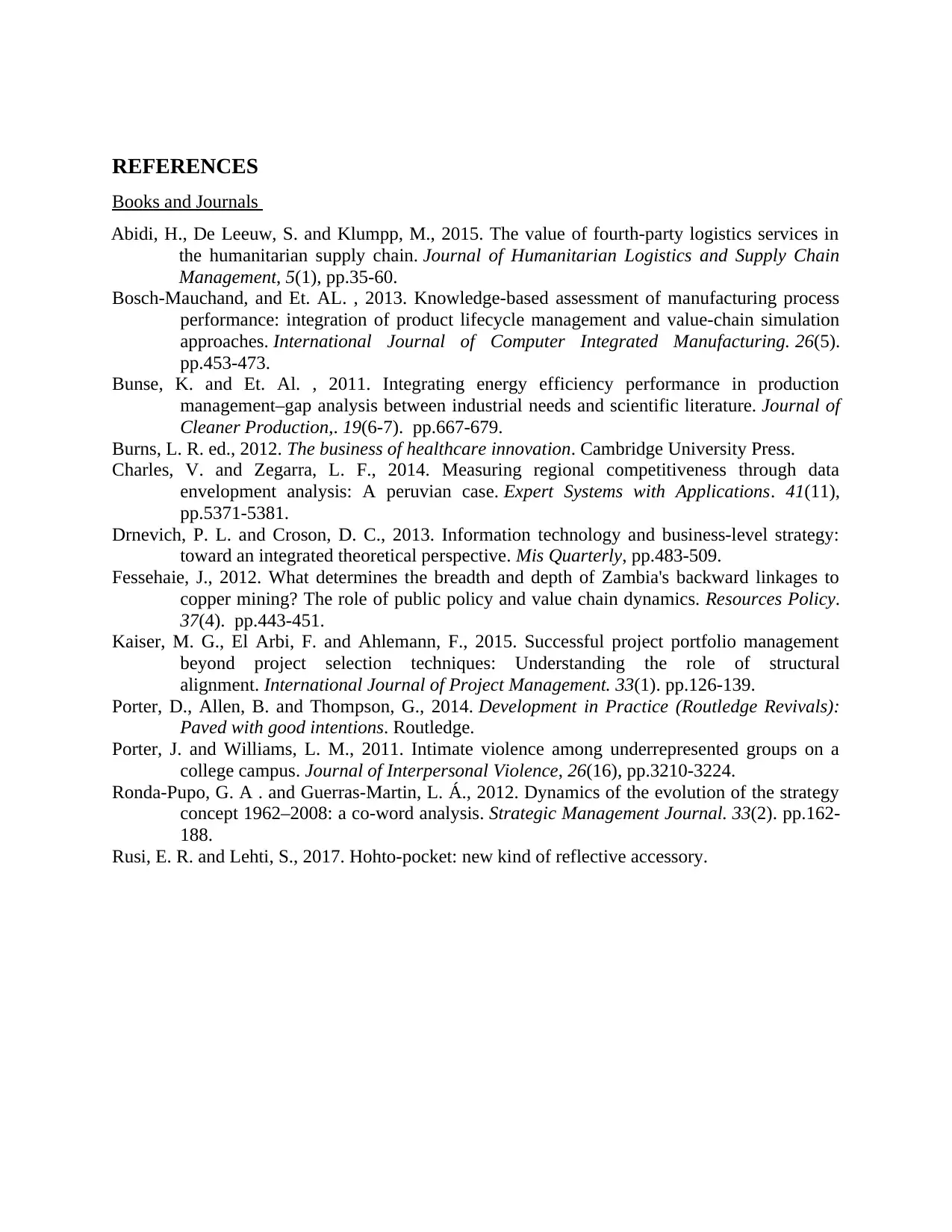
REFERENCES
Books and Journals
Abidi, H., De Leeuw, S. and Klumpp, M., 2015. The value of fourth-party logistics services in
the humanitarian supply chain. Journal of Humanitarian Logistics and Supply Chain
Management, 5(1), pp.35-60.
Bosch-Mauchand, and Et. AL. , 2013. Knowledge-based assessment of manufacturing process
performance: integration of product lifecycle management and value-chain simulation
approaches. International Journal of Computer Integrated Manufacturing. 26(5).
pp.453-473.
Bunse, K. and Et. Al. , 2011. Integrating energy efficiency performance in production
management–gap analysis between industrial needs and scientific literature. Journal of
Cleaner Production,. 19(6-7). pp.667-679.
Burns, L. R. ed., 2012. The business of healthcare innovation. Cambridge University Press.
Charles, V. and Zegarra, L. F., 2014. Measuring regional competitiveness through data
envelopment analysis: A peruvian case. Expert Systems with Applications. 41(11),
pp.5371-5381.
Drnevich, P. L. and Croson, D. C., 2013. Information technology and business-level strategy:
toward an integrated theoretical perspective. Mis Quarterly, pp.483-509.
Fessehaie, J., 2012. What determines the breadth and depth of Zambia's backward linkages to
copper mining? The role of public policy and value chain dynamics. Resources Policy.
37(4). pp.443-451.
Kaiser, M. G., El Arbi, F. and Ahlemann, F., 2015. Successful project portfolio management
beyond project selection techniques: Understanding the role of structural
alignment. International Journal of Project Management. 33(1). pp.126-139.
Porter, D., Allen, B. and Thompson, G., 2014. Development in Practice (Routledge Revivals):
Paved with good intentions. Routledge.
Porter, J. and Williams, L. M., 2011. Intimate violence among underrepresented groups on a
college campus. Journal of Interpersonal Violence, 26(16), pp.3210-3224.
Ronda‐Pupo, G. A . and Guerras‐Martin, L. Á., 2012. Dynamics of the evolution of the strategy
concept 1962–2008: a co‐word analysis. Strategic Management Journal. 33(2). pp.162-
188.
Rusi, E. R. and Lehti, S., 2017. Hohto-pocket: new kind of reflective accessory.
Books and Journals
Abidi, H., De Leeuw, S. and Klumpp, M., 2015. The value of fourth-party logistics services in
the humanitarian supply chain. Journal of Humanitarian Logistics and Supply Chain
Management, 5(1), pp.35-60.
Bosch-Mauchand, and Et. AL. , 2013. Knowledge-based assessment of manufacturing process
performance: integration of product lifecycle management and value-chain simulation
approaches. International Journal of Computer Integrated Manufacturing. 26(5).
pp.453-473.
Bunse, K. and Et. Al. , 2011. Integrating energy efficiency performance in production
management–gap analysis between industrial needs and scientific literature. Journal of
Cleaner Production,. 19(6-7). pp.667-679.
Burns, L. R. ed., 2012. The business of healthcare innovation. Cambridge University Press.
Charles, V. and Zegarra, L. F., 2014. Measuring regional competitiveness through data
envelopment analysis: A peruvian case. Expert Systems with Applications. 41(11),
pp.5371-5381.
Drnevich, P. L. and Croson, D. C., 2013. Information technology and business-level strategy:
toward an integrated theoretical perspective. Mis Quarterly, pp.483-509.
Fessehaie, J., 2012. What determines the breadth and depth of Zambia's backward linkages to
copper mining? The role of public policy and value chain dynamics. Resources Policy.
37(4). pp.443-451.
Kaiser, M. G., El Arbi, F. and Ahlemann, F., 2015. Successful project portfolio management
beyond project selection techniques: Understanding the role of structural
alignment. International Journal of Project Management. 33(1). pp.126-139.
Porter, D., Allen, B. and Thompson, G., 2014. Development in Practice (Routledge Revivals):
Paved with good intentions. Routledge.
Porter, J. and Williams, L. M., 2011. Intimate violence among underrepresented groups on a
college campus. Journal of Interpersonal Violence, 26(16), pp.3210-3224.
Ronda‐Pupo, G. A . and Guerras‐Martin, L. Á., 2012. Dynamics of the evolution of the strategy
concept 1962–2008: a co‐word analysis. Strategic Management Journal. 33(2). pp.162-
188.
Rusi, E. R. and Lehti, S., 2017. Hohto-pocket: new kind of reflective accessory.
1 out of 11
Related Documents
Your All-in-One AI-Powered Toolkit for Academic Success.
+13062052269
info@desklib.com
Available 24*7 on WhatsApp / Email
![[object Object]](/_next/static/media/star-bottom.7253800d.svg)
Unlock your academic potential
Copyright © 2020–2025 A2Z Services. All Rights Reserved. Developed and managed by ZUCOL.





